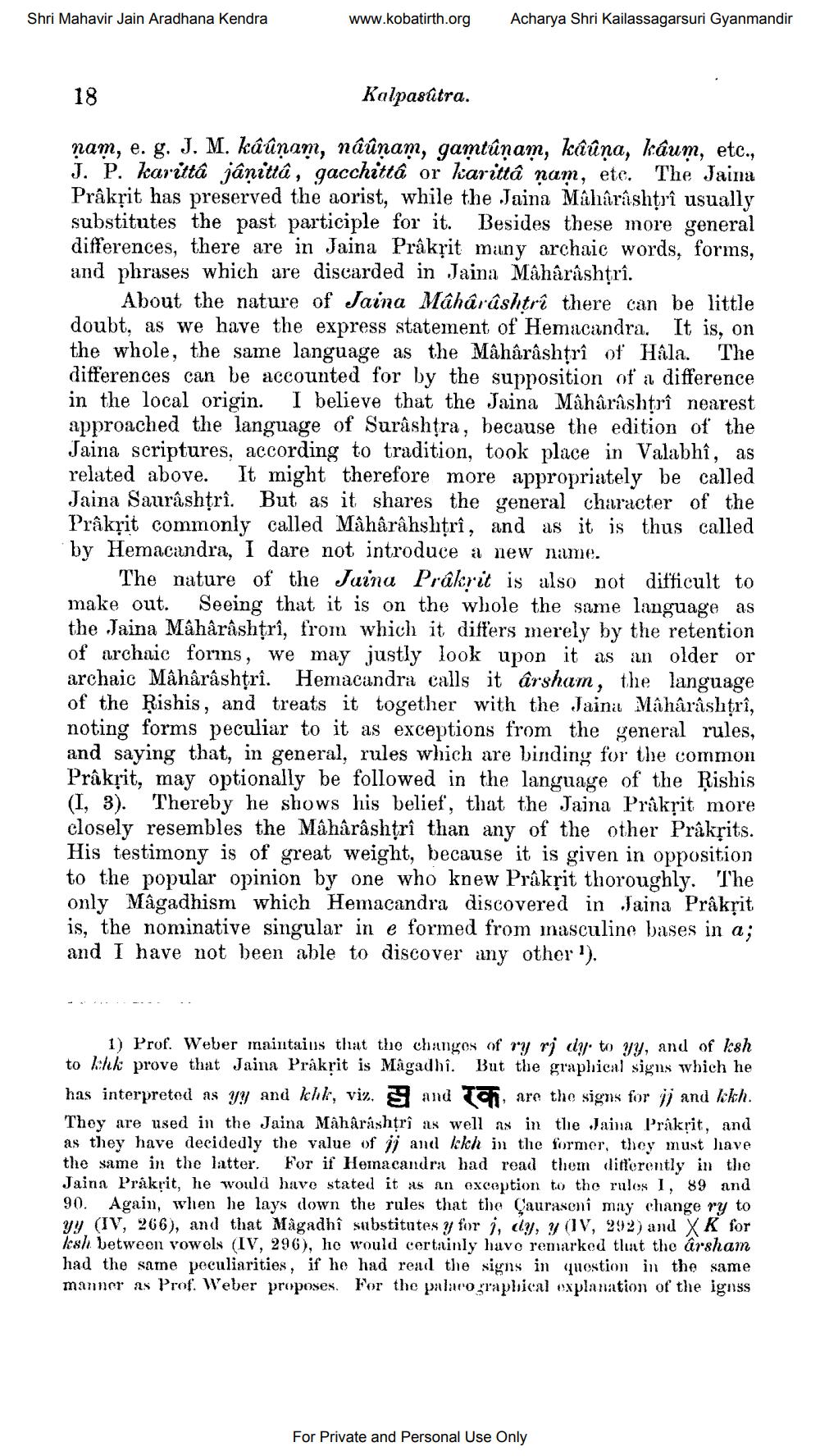________________
Shri Mahavir Jain Aradhana Kendra
www.kobatirth.org
Acharya Shri Kailassagarsuri Gyanmandir
18
Kalpasútra.
nam, e. g. J. M. kâûņam, nâûņam, gamtûņam, kâûņa, kâum, etc., J. P. karitta jânitta, gacchitta or karitta nam, etc. The Jaina Prâkrit has preserved the aorist, while the Jaina Mâhârâshtrî usually substitutes the past participle for it. Besides these more general differences, there are in Jaina Prâkrit many archaic words, forms, and phrases which are discarded in Jaina Mâhârâshtrî.
The
About the nature of Jaina Maharashtra there can be little doubt, as we have the express statement of Hemacandra. It is, on the whole, the same language as the Mâhârâshtrî of Hâla. differences can be accounted for by the supposition of a difference in the local origin. I believe that the Jaina Mâhârâshtrî nearest approached the language of Surâshtra, because the edition of the Jaina scriptures, according to tradition, took place in Valabhî, as related above. It might therefore more appropriately be called Jaina Saurashtrî. But as it shares the general character of the Prakrit commonly called Mâhârâhshṭrî, and as it is thus called by Hemacandra, I dare not introduce a new name.
The nature of the Jaina Prakrit is also not difficult to make out. Seeing that it is on the whole the same language as the Jaina Mâhârâshṭrî, from which it differs merely by the retention of archaic forms, we may justly look upon it as an older or archaic Mâhârâshtri. Hemacandra calls it arsham, the language of the Rishis, and treats it together with the Jaina Mâhârâshtrî, noting forms peculiar to it as exceptions from the general rules, and saying that, in general, rules which are binding for the common Prâkrit, may optionally be followed in the language of the Rishis (1, 3). Thereby he shows his belief, that the Jaina Prakrit more closely resembles the Mâhârâshtrî than any of the other Prâkrits. His testimony is of great weight, because it is given in opposition to the popular opinion by one who knew Prakrit thoroughly. The only Magadhism which Hemacandra discovered in Jaina Prâkrit is, the nominative singular in e formed from masculine bases in a; and I have not been able to discover any other 1).
1) Prof. Weber maintains that the changes of ry rj dy to yy, and of ksh to hk prove that Jaina Prakrit is Magadhi. But the graphical signs which he has interpreted as yy and khk, viz. ♬ and TM, are the signs for jj and kkh. They are used in the Jaina Mâhârâshtrî as well as in the Jaina Prakrit, and as they have decidedly the value of jj and kkh in the former, they must have the same in the latter. For if Hemacandra had read them differently in the Jaina Prakrit, he would have stated it as an exception to the rules I, 89 and 90. Again, when he lays down the rules that the Cauraseni may change ry to yy (IV, 266), and that Magadhi substitutes y for j, dy, y (IV, 292) and XK for ksh between vowels (IV, 296), he would certainly have remarked that the arsham had the same peculiarities, if he had read the signs in question in the same manner as Prof. Weber proposes. For the palaeographical explanation of the ignss
For Private and Personal Use Only




